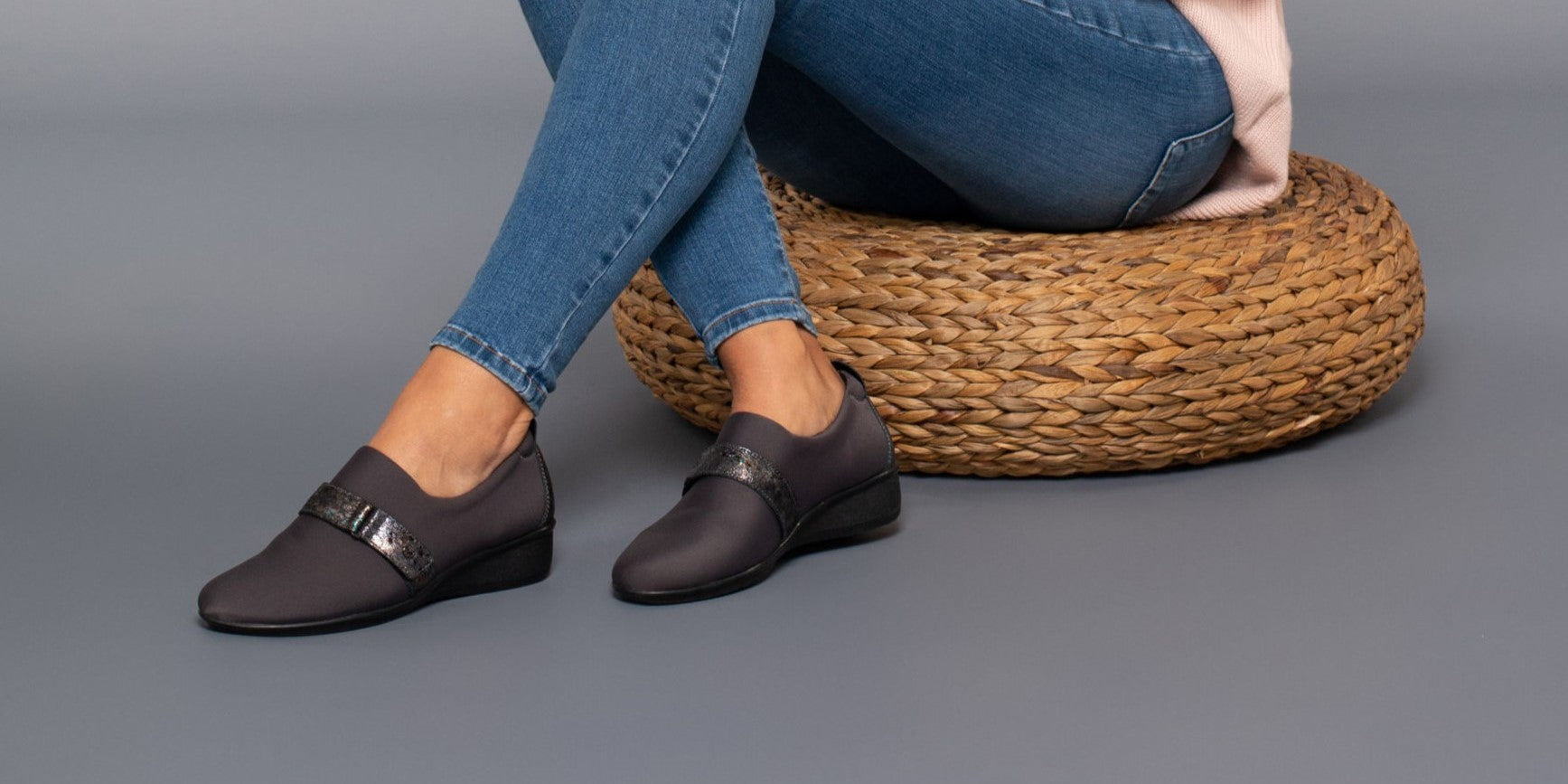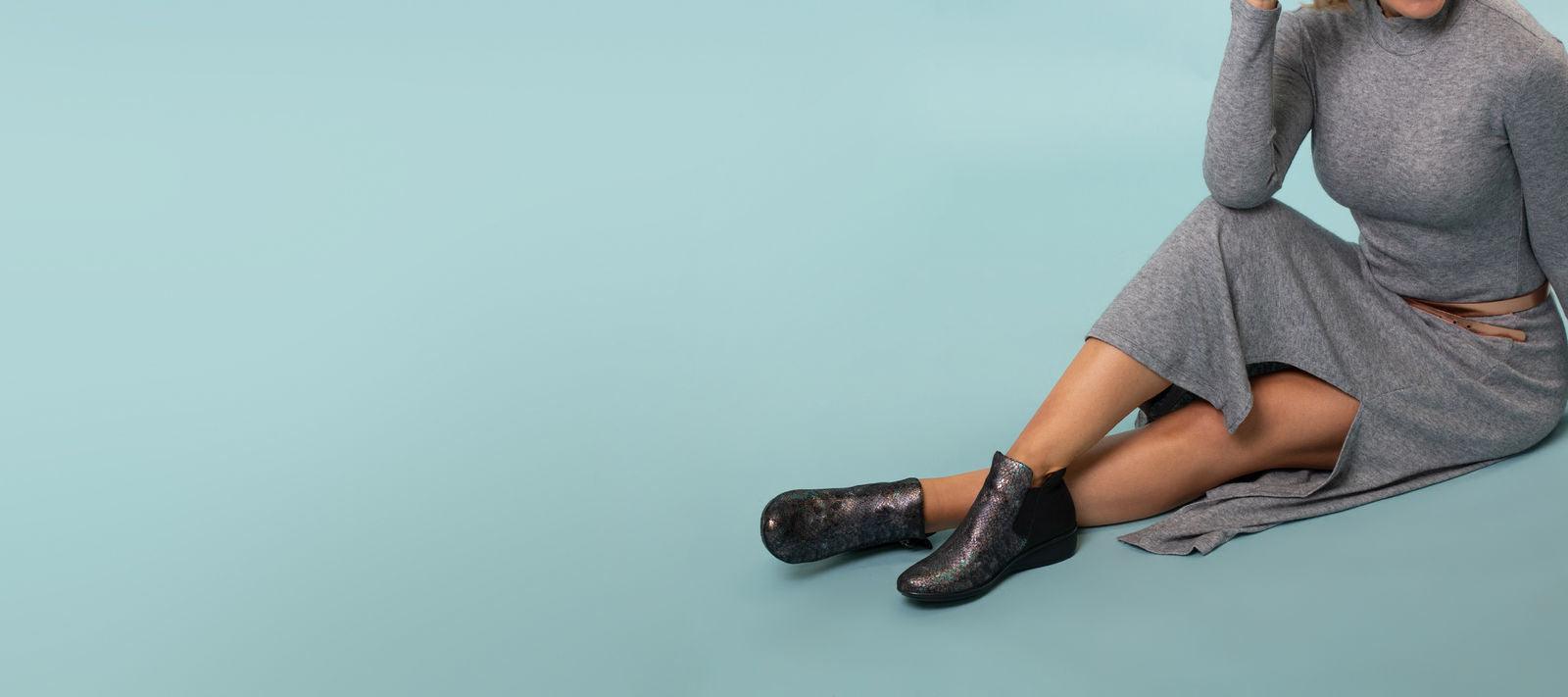Article: The Ultimate Guide to Choosing Shoes for Plantar Fasciitis

The Ultimate Guide to Choosing Shoes for Plantar Fasciitis
Let’s face it, when it comes to plantar fasciitis, proper footwear is non-negotiable. No matter if you’re on your feet all day or not, wearing the wrong shoes is taxing on the body. When a heel is too high or too low, the toe box of your shoe feels too tight, or your footwear has a lack of arch support, it can exacerbate your plantar fasciitis, as these features prevent your foot from molding into its natural position. The distribution of pressure becomes more strained with every step, leading to potential injuries and further pain that can run from the toe to the hips. Isn’t it time you discovered the joys of comfort shoes for plantar fasciitis? We thought as much. By wearing the correct footwear for plantar fasciitis, you’ll feel more comfortable and begin to ease that foot pain. With that in mind, we’ve put together the revere guide to choosing the best shoes for plantar fasciitis.
Look for support
The comfy shoe revolution has entered the history books with a re-emergence of flats and sneakers that are so effortlessly associated with comfort and respite for the feet. However, they must have the features to really support you in your daily life. Cushioning, stability and support for the arch and heel is essential when searching for shoes designed for plantar fasciitis. It is not only about supporting the arch of your foot, but it also helps to ease any pain. Cushioning in a shoe works to protect and comfort your feet as you walk, while arch support prevents the plantar fascia from overstretching any further, reducing pressure and allowing it to heal. The insoles of all revere shoes are contoured and feature built-in arch support that cradles the foot on daily adventures. What more could you ask for?

Note your width
Not all feet are the same - fact! That’s why many of our shoes, from sandals to boots and booties, come in medium and wide fit to cater for everyone. Having this extra room, particularly in the toe box, is excellent for allowing your toes to naturally space out into their natural toe splay, without being confined by tight shoes. A medium or wide fitting shoe also secures your foot without compromising the natural movement of your feet, which is just what we want when it comes to alleviating the pain and pressure caused by plantar fasciitis.
Orthotic inserts
The best shoes for plantar fasciitis will ensure your foot is supported, cushioned and stable, while being orthotic-friendly. Orthotic inserts can be custom-made to address specific structural issues of your feet, with the ability to relieve pain that is associated with plantar fasciitis and stabilize the foot. All closed footwear from revere is orthotic-friendly and features removable footbeds so you can quickly and easily slide your very own custom orthotic into the shoe. For those who do not require a tailor-made orthotic, we have designed our insoles with contours aligned to the natural shape of the foot, with built-in arch support that comforts and protects. That means you can enjoy all the benefits of orthotic-friendly features without having to purchase an extra insole.

Not too high, not too low
Shoes such as stilettos and high heels might look good but they force your feet into an unusual shape, particularly the toes and arch. This places immense pressure on the feet and can heighten any foot pain and other symptoms you suffer from with plantar fasciitis. That doesn’t mean you should go the opposite way, however… Flat shoes without contouring provide very little, if any, support to your arches or stability for the foot. The weight of the foot is not evenly distributed when you wear a pair of fully flat ballerinas, for example. Both of these instances can intensify plantar fasciitis. You should therefore search for something in the middle: not too high, not too low. Swap your vertiginous stilettos for a pair of comfortable wedges or Mary Janes that bring the height and style but assist with reducing metatarsal pressures. If you’re dedicated to your flats, our ballet pumps and loafers have a contoured insole with arch support to ensure your feet are stabilized and aren’t totally flat to the ground. They might just be the best shoes for walking with plantar fasciitis!
Find the perfect fit
Finding the perfect fit sounds simple (and it is with revere) yet so many people are walking in ill-fitting shoes that are either too big or too small. Shoes that do not fit are without a doubt going to aggravate any inflammation and worsen plantar fasciitis. That’s why we provide the perfect fitting shoes for plantar fasciitis with our unique features. The ‘revere fit kit’ comes with our shoes to provide a personalized fit, no matter the style. A forefoot filler helps to secure your heels to avoid them slipping out as you walk, or if your shoes are a little roomy, the full length filler reduces the volume in a shoe and is ideal for those with narrow feet. If you need more width on your wedge sandals without affecting the look, attach our strap extenders, or look out for trim marks to shorten the strap length and reduce the width. All components are included in the fitting kit and allow you to customize your fit to one that is completely unique to you, regardless of whether your feet are narrow, wide or a standard width. After all, when you have the perfect fit, your feet will thank you.
Adjustable fastenings
Shoes with fastenings such as straps and laces will secure your feet so they’re not prone to the extra stress of plantar fasciitis. Sandals with back straps or sneakers with laces can be easily adjusted to perfectly fit the foot, keeping it in place and avoiding unnecessary pain. Again, revere trim marks mean you can shorten the straps around the ankle if required, while strap extensions provide a wider fit to support alignment.

Measure your feet
We touched on how important it is to find the perfect fit of your comfort shoes for plantar fasciitis, but when was the last time you measured your feet? Believe it or not, the size of your feet can change throughout your lifetime because of many factors. It’s very likely that your feet are not the same size as they were many years ago (sorry to break the news) and so, you may be wearing the wrong shoe size. Measuring your feet was a custom as a child, but it should become just as frequent a task as an adult. Doing so will help you determine the best shoe size and consequently you might just wave goodbye to any further plantar fasciitis symptoms entering your life! Here is our go-to guide for finding the right shoe size at home.
Our top tips for choosing the best shoes for plantar fasciitis
What to look for:
- Firm sole
- Adequate cushioning
- Arch support
What to avoid:
- Flat shoes with no arch support
- High shoes that alter your arch shape
- Shoes that are too big or too small




